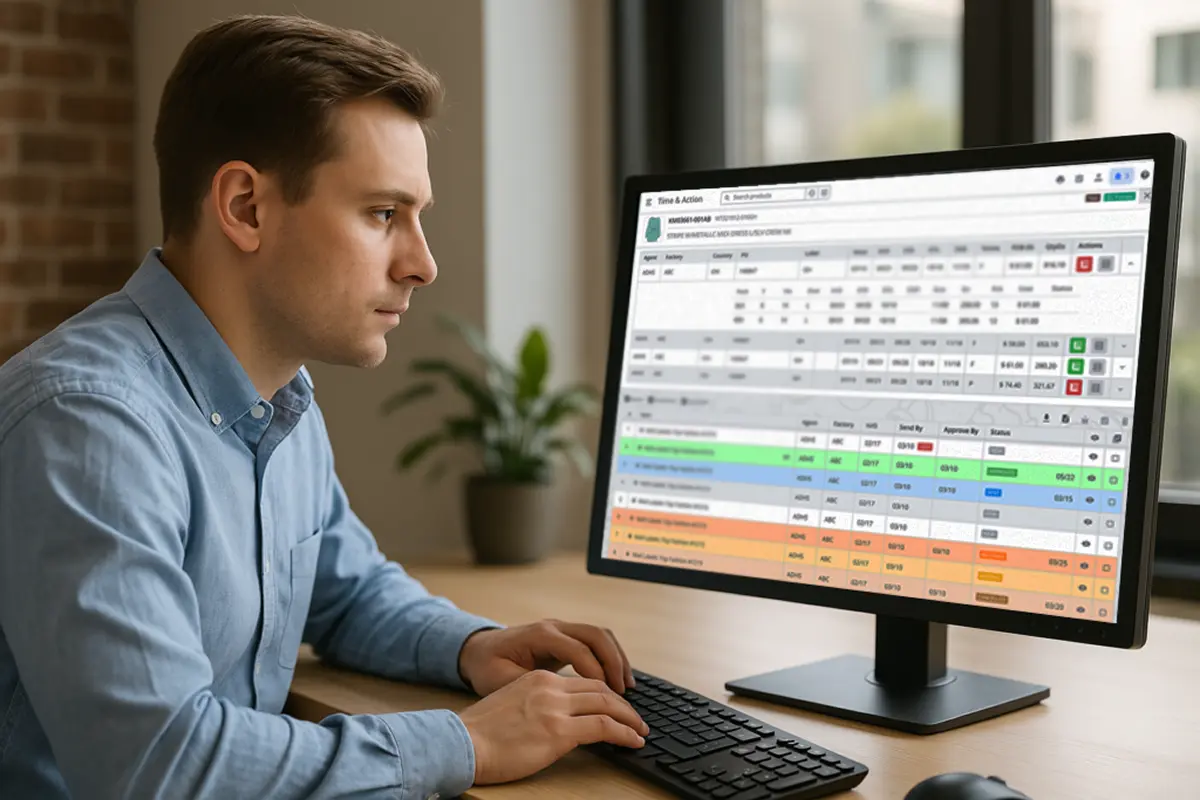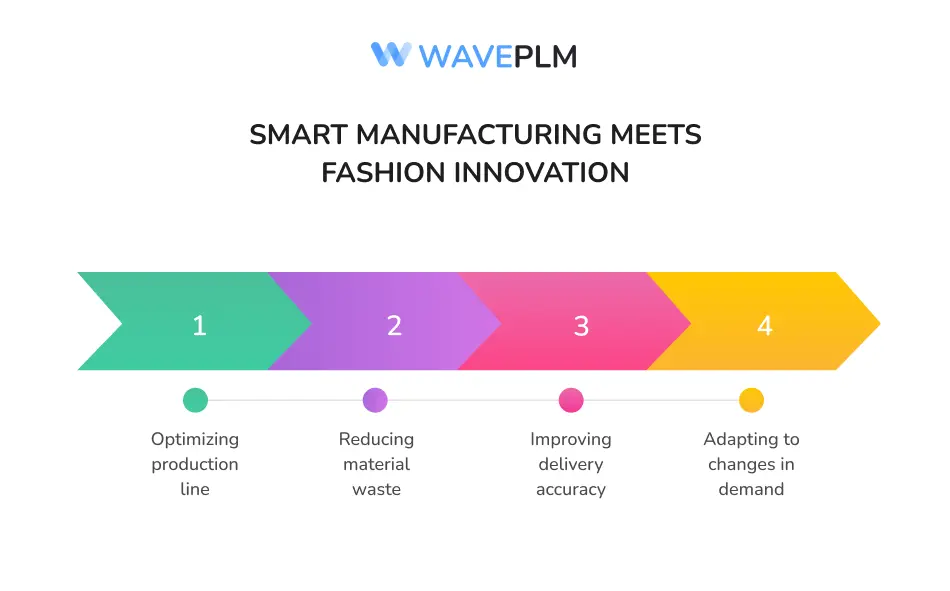
In today’s fast-paced and competitive fashion industry, brands must respond quickly and efficiently to shifting trends, customer preferences, and supply chain challenges. Apparel workflow automation empowers them to do just that. It drives production efficiency, reduces errors, speeds up time to market, and supports informed decision-making. When integrated with fashion PLM software, automation doesn’t just improve isolated tasks—it transforms the entire production process.
Let’s take a deeper look at how automating apparel workflows leads to true digital transformation, enhanced productivity, and measurable results across every department in your fashion business.
What is Apparel Workflow Automation?
Apparel workflow automation refers to the use of digital technology to manage and streamline repetitive, manual tasks across the production process. These include approvals, data handoffs, milestone tracking, and communication within the product development pipeline. Automation tools minimize errors, reduce bottlenecks, and ensure consistent progress.
| Manual Process | Automated Process |
|---|---|
| Email approvals | Auto-triggered notifications |
| Spreadsheet tracking | Centralized PLM dashboards |
| File version confusion | Real-time collaboration in PLM |
| Task follow-ups | Automated reminders and task management |
| Disconnected updates | Live tracking with digital workflows |
Instead of relying on emails, spreadsheets, and scattered tools, teams use centralized systems that update automatically. This creates a single source of truth for everyone involved.
How Workflow Automation Powers Digital Transformation
Digital transformation is not only about switching to software. It requires a mindset shift and operational overhaul. It means using technology to rethink how fashion brands work, communicate, and deliver value.
Automated fashion processes bring structure and speed to every step of the product journey. From ideation to design, sourcing, production, and delivery—automation streamlines each phase. Workflow automation also supports data-driven decisions. It provides accurate information at the right time, reducing uncertainty and increasing confidence in choices.
By automating your apparel process, you:
- Increase production consistency
- Respond faster to demand
- Create transparency across departments
- Eliminate duplicated efforts

Key Benefits of Apparel Workflow Automation
| Benefit | Impact on Fashion Production |
|---|---|
| Faster approvals | Shorter product timelines and quicker releases |
| Reduced errors | Improved quality and fewer remakes |
| Centralized information | Better team collaboration and fewer miscommunications |
| Task visibility | More informed decision-making |
| Cost-effective workflows | Reduces operational costs |
| Continuous improvement | Trackable metrics and process optimization |
| Enhanced compliance | Automate standards and reduce audit risks |
Improving Productivity and Efficiency at Every Level
Apparel workflow automation boosts productivity by eliminating the need for repetitive manual work. Brands automate sample tracking, tech pack sharing, supplier communication, BOM updates, and more. This allows designers, product developers, and sourcing teams to focus on high-value creative tasks.
Fashion PLM software like Wave PLM provides an integrated platform for managing this. It acts as a hub where all departments align, from design to production. Updates made in one area reflect across the board. Automated systems keep everyone informed and prevent tasks from falling through the cracks.
This leads to:
- Improved time management
- More accurate product data
- Real-time monitoring of the production line
- Less rework and delay
Fashion PLM Software: The Heart of Your Automation Strategy
Product Lifecycle Management (PLM) software is the backbone of apparel process automation. It helps manage every detail in product development, from initial concepts to final delivery. Automation within PLM tools transforms scattered workflows into cohesive systems.
| PLM Feature | Automation Role |
|---|---|
| Tech pack management | Auto-versioning and instant sharing |
| BOM tracking | Real-time updates on material usage |
| Sample status updates | Automated notifications for each milestone |
| Approval routing | Rules-based task assignment and alerts |
| Supplier collaboration | Secure portals for shared documents and feedback |
Wave PLM ensures that changes made by one team member instantly update across the system. That reduces communication errors and keeps everyone aligned on next steps.
Smart Manufacturing Meets Fashion Innovation
Smart manufacturing brings together advanced technologies like artificial intelligence (AI), IoT sensors, and machine learning. In fashion, these tools help improve the manufacturing process by offering real-time visibility and predictive insights.
Workflow automation in smart manufacturing environments identifies inefficiencies, delays, and potential issues before they become major problems. AI tools analyze past performance and current social media signals to suggest improvements. They help brands forecast demand, align production capacity, and reduce inventory risks.
With smart automation, fashion brands:
- Optimize their production line
- Reduce material waste
- Improve delivery accuracy
- Adapt quickly to changes in demand

Product Development Automation: Get to Market First
Speed matters more than ever in fashion. Product development automation accelerates the path from concept to launch. It reduces approval loops, ensures data consistency, and cuts down manual data entry across teams.
By automating version control, compliance checks, and calendar tasks, teams reduce delays and hit launch dates more consistently. This leads to:
- Greater customer satisfaction
- Improved brand reputation
- Competitive advantage in seasonal collections
Reducing Waste and Building a Sustainable Future
Inaccuracies in data and processes often lead to overproduction, fabric waste, and missed shipments. Workflow automation ensures that what gets designed is what gets made—with precision. Automated BOMs, real-time inventory updates, and tracked approvals help cut waste at every level.
That makes your brand not only more efficient but also more sustainable.
Real-Life Examples: How Leading Brands Use Automation
| Brand Challenge | Automation Solution | Result |
|---|---|---|
| Slow sample approvals | PLM auto-routes tasks to stakeholders | Faster decision-making |
| Disconnected teams | Centralized workflows in Wave PLM | Improved communication and alignment |
| Material shortages | Real-time raw material tracking | Fewer production delays |
| Trend misalignment | AI insights from social media | Better product-market fit |
| Data loss in handoffs | Integrated digital records | Full traceability and reduced errors |
5 Steps to Automate Your Apparel Workflow
- Map your current process. List out each task in your production process from design to delivery
- Pick the right PLM software. Look for strong automation features, real-time tracking, and integration options
- Start with high-impact areas. Begin automation with sample approvals, BOM updates, and production tracking
- Train your team thoroughly. Ensure all team members understand the benefits and how to use the tools
- Monitor, measure, and improve. Use reporting tools to identify bottlenecks and apply continuous improvement strategies
Why Workflow Automation Matters More Than Ever
Fashion continues to evolve rapidly. Digital technology, AI tools, and other advanced innovations are becoming critical to staying competitive. Consumers expect personalized, timely, and sustainable fashion products.
Brands that rely on manual, disconnected systems fall behind. Automated systems offer accuracy, speed, and scalability. They empower teams to respond to trends, handle supply chain complexity, and exceed customer expectations.
Automation is the foundation of the modern fashion business. It’s the only way to scale with speed and confidence.
Conclusion: Transform Your Fashion Business with Smart Automation
Apparel workflow automation is no longer optional. It’s a strategic investment in the future of your fashion brand. By embracing automated fashion processes and digital technology, you unlock better collaboration, reduced waste, faster production, and greater agility.
Fashion PLM software plays a central role in managing this transformation. It connects design, sourcing, production, and marketing under one digital roof.
The result? Improved efficiency, increased customer satisfaction, and a long-term competitive advantage. Start your digital transformation journey today with smart, cost-effective automation powered by Wave PLM.
Template: Apparel Workflow Automation Checklist
| Task Area | Manual? | Automated? | Notes |
|---|---|---|---|
| Sample approvals | Yes | Use PLM to route and track approvals | |
| BOM updates | Yes | Automate updates across departments | |
| Tech pack sharing | Yes | Enable real-time collaboration | |
| Raw material tracking | Yes | Use dashboards for live inventory data | |
| Social media trend input | No | Integrate AI tools for insight | |
| Compliance checks | Yes | Set rules to automate standard checks | |
| Production line tracking | Yes | Use IoT-enabled devices to monitor stages | |
| Approval status visibility | Yes | Enable automated status flags in PLM |
Use this checklist to evaluate your current processes and discover automation opportunities across your entire workflow.
Need help getting started? Contact the team at Wave PLM to learn how apparel workflow automation can take your brand to the next level.





Leave a Reply